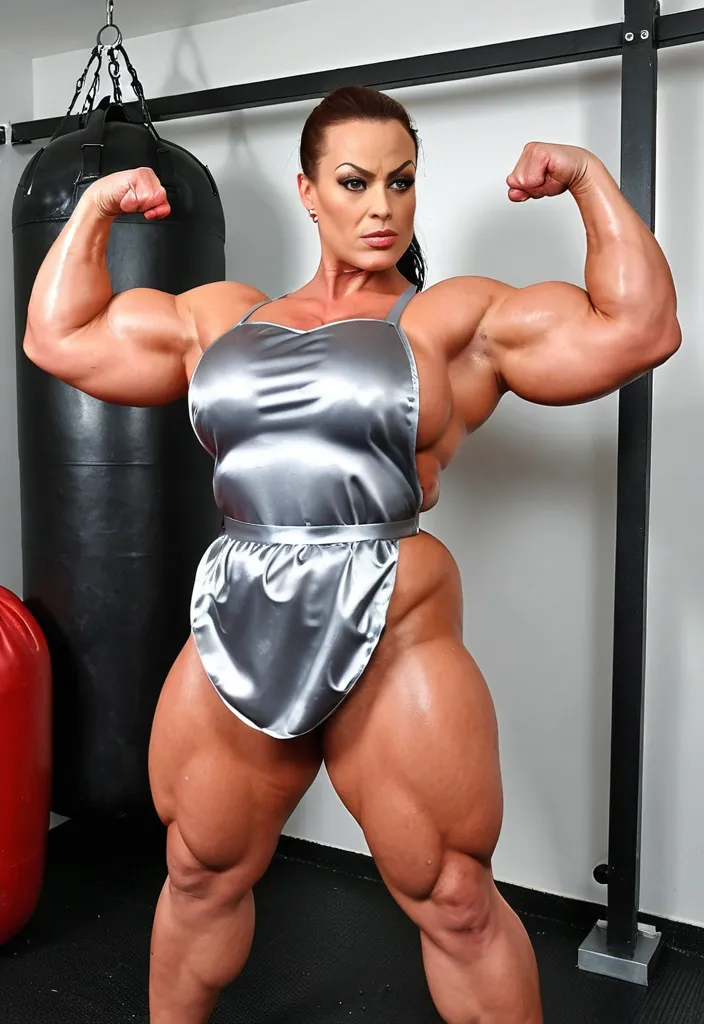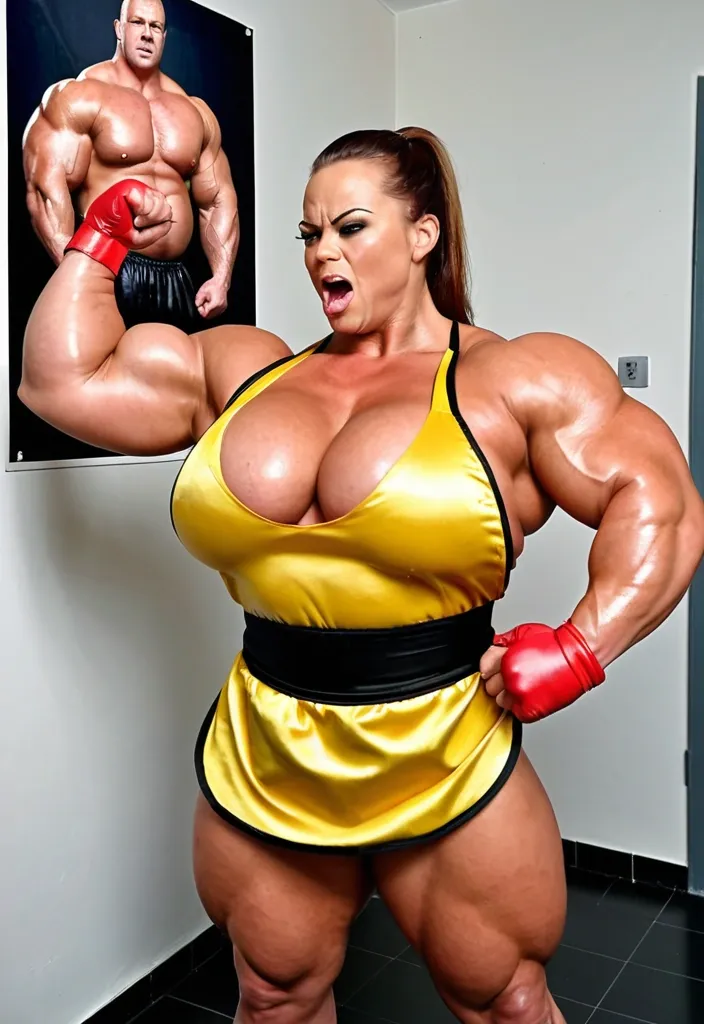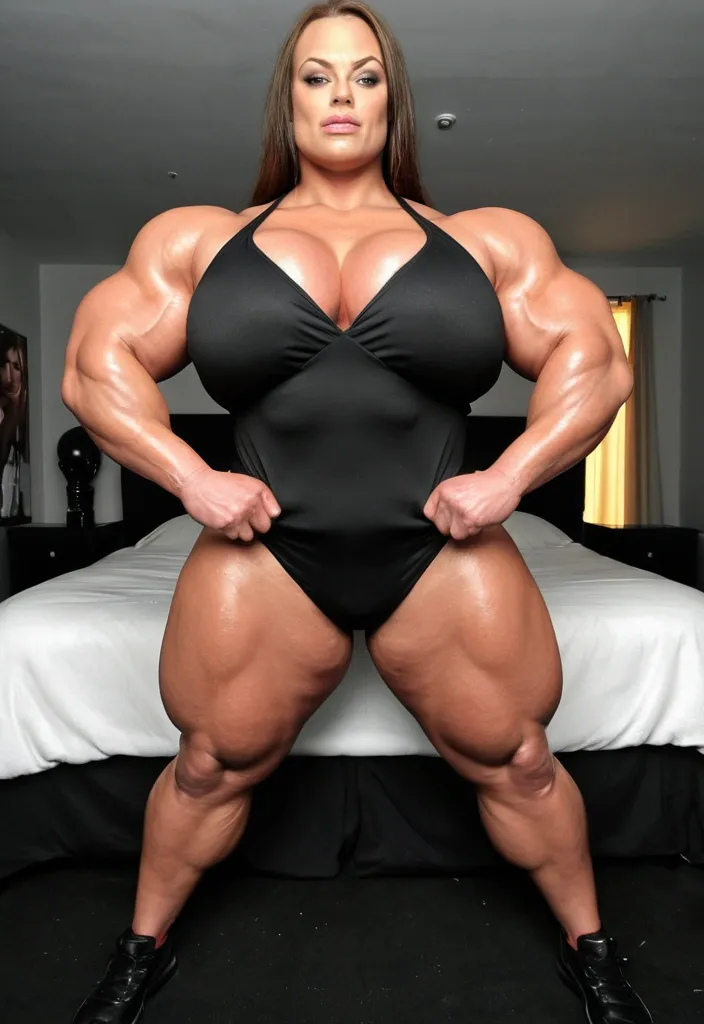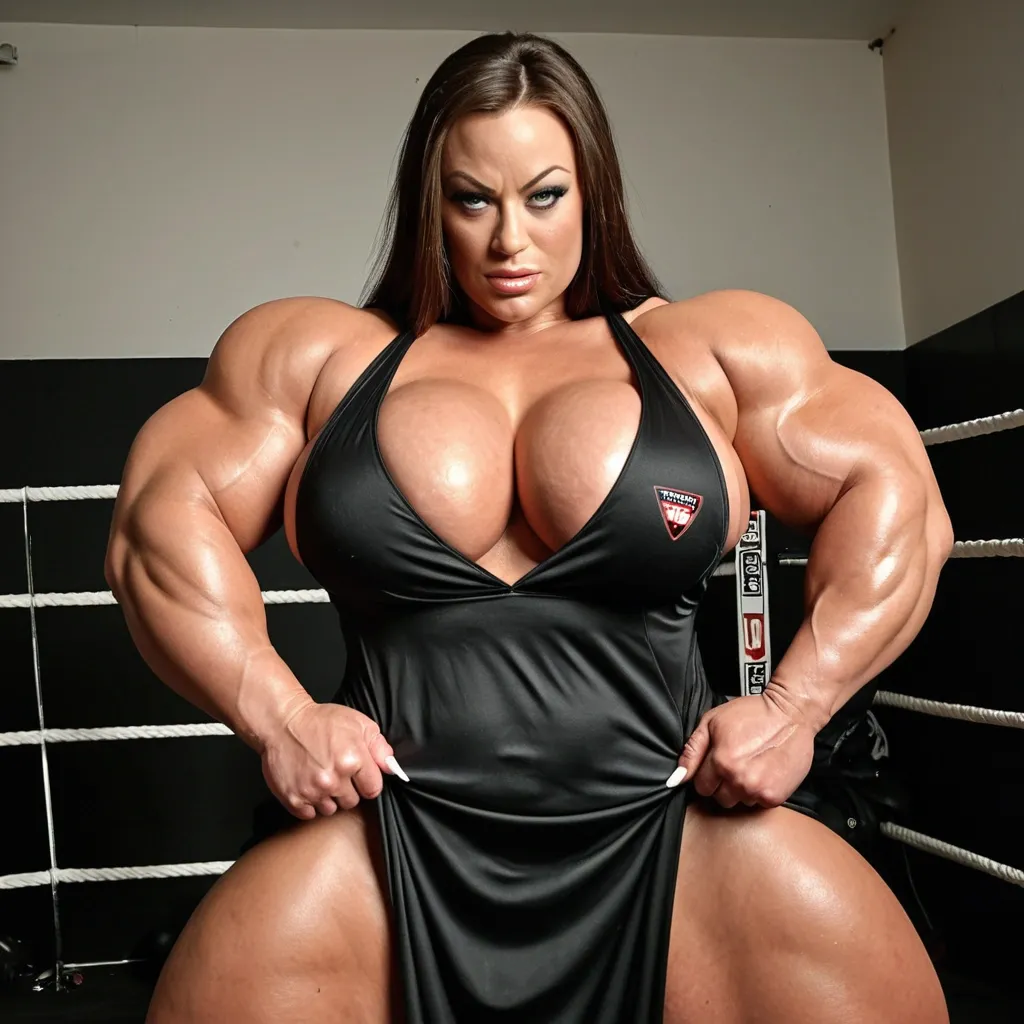AI Image Prompts for Wilde
Explore AI generated designs, images, art and prompts by top community artists and designers.

Plan de profil de Very bbw bimbo muscular too busty housewife with too big implants breast , enormous ass , bbw muscular enormous bimbo powerlifteuse , abnormally massive female muscular bodybuilder , bbw , Géante dame , very big ass , curvacious , gorgeous , Olivia wilde face , flexing arms while bathing with soaked clothes in a shower , wearing a white satin maid tight tablier apron , gros seins en évidence , gros biceps énormes , flexing muscles , cuisses en évidence , flexing biceps , make up , muscle show poster , vue de profil ,

Plan de profil de Very bbw bimbo muscular too busty housewife with too big implants breast , enormous ass , bbw muscular enormous bimbo powerlifteuse , abnormally massive female muscular bodybuilder , bbw , Géante dame , very big ass , curvacious , gorgeous , Olivia wilde face , bare fist handed punch on a punching-bag in a shower in front of onlookers , wearing a gris clair satin maid tight tablier apron , gros seins en évidence , gros biceps énormes , flexing muscles , cuisses en évidence , flexing biceps , make up , muscle show poster , vue de profil ,

Plan de profil de Very bbw bimbo muscular too busty housewife with too big implants breast , enormous ass , bbw muscular enormous bimbo powerlifteuse , abnormally massive female muscular bodybuilder , bbw , Géante dame , very big ass , curvacious , gorgeous , Olivia wilde face , bare fist handed punch on a punching-bag in a shower in front of onlookers , wearing a violet satin tight maid tablier apron , gros seins en évidence , gros biceps énormes , flexing muscles , cuisses en évidence , flexing biceps , make up , muscle show poster , vue de profil ,

Plan de profil de Very bbw bimbo muscular too busty housewife with too big implants breast , enormous ass , bbw muscular enormous bimbo powerlifteuse , abnormally massive female muscular bodybuilder , bbw , Géante dame , very big ass , curvacious , gorgeous , Olivia wilde face , bare fist handed punch on a punching-bag in a shower in front of onlookers , wearing a tight jaune satin maid tablier apron , gros seins en évidence , gros biceps énormes , flexing muscles , cuisses en évidence , flexing biceps , make up , muscle show poster , vue de profil ,

Plan de profil de Very bbw bimbo muscular too busty housewife with too big implants breast , enormous ass , bbw muscular enormous bimbo powerlifteuse , abnormally massive female muscular bodybuilder , bbw , Géante dame , very big ass , curvacious , gorgeous , Olivia wilde face , bare fist handed punch on a punching-bag in a shower in front of onlookers , wearing a white clair satin wet housewife night shirt décolletée with light bra , gros seins en évidence , gros biceps énormes , flexing muscles , cuisses en évidence , flexing biceps , make up , muscle show poster , vue de profil ,

Plan de profil de Very bbw bimbo muscular too busty housewife with too big implants breast , enormous ass , bbw muscular enormous bimbo powerlifteuse , abnormally massive female muscular bodybuilder , bbw , Géante dame , very big ass , curvacious , gorgeous , Olivia wilde face , bare fist handed punch on a punching bag in a shower in front of onlookers , wearing a white cotton wet housewife long tight towel , gros seins en évidence , gros biceps énormes , flexing muscles , cuisses en évidence , flexing biceps , make up , muscle show poster , vue de profil ,

Plan de profil de Very bbw bimbo muscular too busty housewife with too big implants breast , enormous ass , bbw muscular enormous bimbo powerlifteuse , abnormally massive female muscular bodybuilder , bbw , Géante dame , very big ass , curvacious , gorgeous , Olivia wilde face , bare fist handed punch on a punching bag in a shower in front of onlookers , wearing a white cotton wet housewife long tight towel , gros seins en évidence , gros biceps énormes , flexing muscles , cuisses en évidence , flexing biceps , make up , muscle show poster , vue de profil ,

Plan de profil de Very bbw bimbo muscular too busty housewife with too big implants breast , enormous ass , bbw muscular enormous bimbo powerlifteuse , abnormally massive female muscular bodybuilder , bbw , Géante dame , very big ass , curvacious , gorgeous , Olivia wilde face , bare fist handed punch on a punching bag in a shower in front of onlookers , wearing a bordeaux satin wet housewife mini apron , gros seins en évidence , gros biceps énormes , flexing muscles , cuisses en évidence , flexing biceps , make up , muscle show poster , vue de profil ,

Plan de profil de Very bbw bimbo muscular too busty housewife with too big implants breast , enormous ass , bbw muscular enormous bimbo powerlifteuse , abnormally massive female muscular bodybuilder , bbw , Géante dame , very big ass , curvacious , gorgeous , Olivia wilde face , bare fist handed punch on a punching bag in a shower in front of onlookers , wearing a blue clair latex wet housewife 50s mini dress , gros seins en évidence , gros biceps énormes , flexing muscles , cuisses en évidence , flexing biceps , make up , muscle show poster , vue de profil ,

Plan de profil de Very big Gorgeous muscular housewife with too big breast , enormous ass , bbw muscular enormous bimbo powerlifteuse , abnormally massive female muscular bodybuilder , bbw , Géante dame , very big ass , curvacious , gorgeous , Olivia wilde face , standing in a guest room , wearing a long tight slit satin housewife dress , gros biceps énormes , flexing muscles , cuisses en évidence , flexing biceps , make up , muscle show poster , vue de profil ,

Plan de profil de Very big Gorgeous muscular housewife with too big breast , enormous ass , bbw muscular enormous bimbo powerlifteuse , abnormally massive female muscular bodybuilder , bbw , Géante dame , very big ass , curvacious , gorgeous , Olivia wilde face , standing in a guest room , wearing a long slit nun's outfit décolletée , gros biceps énormes , flexing muscles , cuisses en évidence , flexing biceps , make up , muscle show poster , vue de profil ,

Plan de profil de Very big Gorgeous muscular housewife with too big breast , enormous ass , bbw muscular enormous bimbo powerlifteuse , abnormally massive female muscular bodybuilder , bbw , Géante dame , very big ass , curvacious , gorgeous , Olivia wilde face , standing in a guest room , wearing a long tight slit nun's outfit , gros biceps énormes , flexing muscles , cuisses en évidence , flexing biceps , make up , muscle show poster , vue de profil ,

Plan de profil de Very big Gorgeous muscular housewife with too big breast , enormous ass , bbw muscular enormous bimbo powerlifteuse , abnormally massive female muscular bodybuilder , bbw , Géante dame , very big ass , curvacious , gorgeous , Olivia Wilde face , standing in a guest room , wearing a long tight slit open satin dress , gros biceps énormes , flexing muscles , cuisses en évidence , flexing biceps , make up , muscle show poster , vue de profil ,

Hochdetailiert , masterpiece: Eine heilige Brücke aus flüssigem Glas über einem Fluss aus Tinte. Linkes Ufer: Präzise geometrische Gärten mit Kristallbäumen. Rechtes Ufer: Wilde Blumenwiesen mit schwebenden Inseln. Auf der Brücke: Ein Kind baut Sandburgen , die zu Architekturmodellen werden. Stil: Fantasy-Illustration | Farben: Kobaltblau | Moosgrün | Sonnengelb Harmonische Effekte: fubunacci Geometrie: Lichtreflexionen auf Glas | Sanfte Dunstschleier , lightrays | Leuchtende Pollen Format: Panorama (21:9) , Octane render ,

masterpiece: Eine Brücke aus flüssigem Glas über einem Fluss aus Tinte. Linkes Ufer: Präzise geometrische Gärten mit Kristallbäumen. Rechtes Ufer: Wilde Blumenwiesen mit schwebenden Inseln. Auf der Brücke: Ein Kind baut Sandburgen , die zu Architekturmodellen werden. Stil: Fantasy-Illustration | Farben: Kobaltblau | Moosgrün | Sonnengelb Harmonische Effekte: Lichtreflexionen auf Glas | Sanfte Dunstschleier | Leuchtende Pollen Format: Panorama (21:9) ,

Plan de profil de Very big Gorgeous housewife with too big breast , enormous ass , bbw muscular enormous bimbo powerlifteuse , abnormally massive female muscular bodybuilder , bbw , Géante dame , Olivia wilde face , very big ass , curvacious , gorgeous , standing on a narrow train with seated passengers she trains hardly bare handed on a punching bag by bare-fist , wearing short strapless dress in shiny black latex , gros biceps énormes , flexing muscles , cuisses en évidence , flexing biceps , make up , sexiest pov poster , vue de profil ,

Plan de profil de Very big Gorgeous housewife with too big breast , enormous ass , bbw muscular enormous bimbo powerlifteuse , abnormally massive female muscular bodybuilder , bbw , Géante dame , Olivia wilde face , very big ass , curvacious , gorgeous , in the gym at evening in a very narrow corridor she trains bare handed on a punching bag by bare-fist , wearing housewife transparent shirt tied around chest with strapless bra , gros biceps énormes , flexing muscles , cuisses en évidence , flexing biceps , make up , sexiest pov poster , vue de profil ,

Plan de profil de Very big Gorgeous housewife with too big breast , enormous ass , bbw muscular enormous bimbo powerlifteuse , abnormally massive female muscular bodybuilder , bbw , Géante dame , Olivia wilde face , very big ass , curvacious , gorgeous , In a narrow room she trains bare handed on a punching bag by bare-fist punching , wearing a tight shortest satin skirt with strapless bra , gros biceps énormes , flexing muscles , cuisses en évidence , flexing biceps , make up , sexiest pov poster , vue de profil ,

Plan de profil de Very big Gorgeous housewife with too big breast , enormous ass , bbw muscular enormous bimbo powerlifteuse , abnormally massive female muscular bodybuilder , bbw , Géante dame , Olivia Wilde face , very big ass , curvacious , gorgeous , on a narrow office with the very short old boss , wearing tight transparent maid dress décolletée , gros biceps énormes , flexing muscles , cuisses en évidence , flexing biceps , make up , sexiest pov poster , vue de profil ,

Plan de profil de Very big Gorgeous housewife with too big breast , enormous ass , bbw muscular enormous bimbo powerlifteuse , abnormally massive female muscular bodybuilder , bbw , Géante dame , Olivia Wilde face , very big ass , curvacious , gorgeous , in the showroom dress in front client , wearing housewife tight transparent dentelle black night dress décolletée , gros biceps énormes , flexing muscles , cuisses en évidence , flexing biceps , make up , sexiest pov poster , vue de profil ,

Plan de profil de Very big Gorgeous housewife with too big breast , enormous ass , bbw muscular enormous bimbo powerlifteuse , abnormally massive female muscular bodybuilder , bbw , Géante dame , Olivia Wilde face , very big ass , curvacious , gorgeous , in the showroom dress in front client , wearing housewife tight transparent dentelle white night dress décolletée , gros biceps énormes , flexing muscles , cuisses en évidence , flexing biceps , make up , sexiest pov poster , vue de profil ,

Very big Gorgeous female too big breast , bbw muscular enormous bimbo powerlifteuse , abnormally massive female muscular bodybuilder , bbw , Géante dame , Olivia wilde face , curvacious , gorgeous , wearing sexiest satin black sleep club dress décolletée , gros biceps énormes , flexing muscles , cuisses en évidence , flexing biceps , make up , pov boxing poster , chaussures talons ,

Very big Gorgeous female stripper big breast , bbw muscular enormous bimbo powerlifteuse , abnormally massive female muscular bodybuilder , bbw , Géante dame , Olivia wilde face , curvacious , gorgeous , wearing sexiest sensual black sleep club dress décolletée , gros biceps énormes , flexing muscles , cuisses en évidence , flexing biceps , make up , pov boxing poster ,

Very big Gorgeous female too big breast , bbw muscular enormous bimbo powerlifteuse , abnormally massive female muscular bodybuilder , bbw , Géante dame , Olivia wilde face , curvacious , gorgeous , wearing sexiest sensual black sleep club dress décolletée , gros biceps énormes , flexing muscles , cuisses en évidence , flexing biceps , make up , pov boxing poster ,

Very big Gorgeous female stripper big breast , bbw muscular enormous bimbo powerlifteuse , abnormally massive female muscular bodybuilder , bbw , Géante dame , Olivia wilde face , curvacious , gorgeous , wearing sexiest sensual black sleep club dress décolletée , gros biceps énormes , flexing muscles , cuisses en évidence , flexing biceps , make up , pov boxing poster ,

Very big Gorgeous female too big breast , bbw muscular enormous bimbo powerlifteuse , abnormally massive female muscular bodybuilder , bbw , Géante dame , Olivia wilde face , curvacious , gorgeous , wearing sexiest sensual black sleep club dress décolletée , gros biceps énormes , flexing muscles , cuisses en évidence , flexing biceps , make up , pov boxing poster ,

Very big Gorgeous female too big breast , bbw muscular enormous bimbo powerlifteuse , abnormally massive female muscular bodybuilder , bbw , Géante dame , Olivia wilde face , curvacious , gorgeous , wearing sexiest sensual black sleep club dress décolletée , gros biceps énormes , flexing muscles , cuisses en évidence , flexing biceps , make up , pov boxing poster ,

Very big Gorgeous female stripper big breast , bbw muscular enormous bimbo powerlifteuse , abnormally massive female muscular bodybuilder , bbw , Géante dame , Olivia wilde face , curvacious , gorgeous , wearing sexiest sensual sleep club dress décolletée , gros biceps énormes , flexing muscles , cuisses en évidence , flexing biceps , make up , pov boxing poster ,

Very big Gorgeous female too big breast , bbw muscular enormous bimbo powerlifteuse , abnormally massive female muscular bodybuilder , bbw , Géante dame , Olivia wilde face , curvacious , gorgeous , wearing sexiest sensual black sleep club dress décolletée , gros biceps énormes , flexing muscles , cuisses en évidence , flexing biceps , make up , pov boxing poster ,

Very big Gorgeous female stripper too big breast , bbw muscular enormous bimbo powerlifteuse , abnormally massive female muscular bodybuilder , bbw , Géante dame , Olivia wilde face , curvacious , gorgeous , wearing sexiest satin pink sleep club dress décolletée , gros biceps énormes , flexing muscles , cuisses en évidence , flexing biceps , make up , pov boxing poster , chaussures talons ,